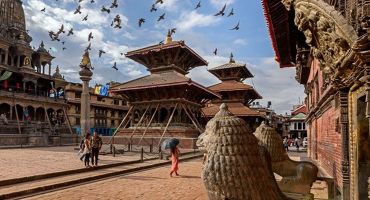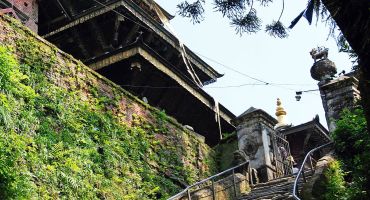As Yalambar conquered Nepal valley (Kathmandu) beginning from Sangha (East Kathmandu) to Gokarna (north Kathmandu), he consolidated his empire completely by taking over Jolpringram (modern-day Thankot) in around 1700 B.C (Date Source: calculated according to Gopala Vamshali). Thankot was named “Jolpringram” by the Kiratas. The word “gram” used as a suffix in the name “Jolpringram” suggests that it was an important town during the Kirata era.
The Kiratas also used the term “Pringa” to denote any settlement or village on a “hill”. The name “Jol-prin-gram” uses both the suffixes respectively, “Pringa” and “gram”. Needless to say, anyone who has ever been to Kathmandu knows that Thankot is located on a hill. When the Lichhavis took over the Nepal valley, they also took over already existing Kirata towns and made it their own. The Lichhavis changed the name “Jolpringram” to “Jayapalikagram” and made it their trade hub. Thus, most towns of the Kirata era are today important centers of modern Kathmandu.
There isn’t many historical data from which we can derive what the Nepal valley Kiratas were like in ancient times. There are a few documents and Lichhavi inscriptions from which we can decipher their social and religious understanding. It is certain that the Kiratas spoke a very distinctive language that didn’t have any relation with the Sanskrit language of the Lichhavi people. The word “gram” in Lichhavi inscriptions is of Sanskrit origin but the word “Pringa” isn’t. So we can fairly ascertain that the word gram was a suffix added by the Lichhavis. The word Pringa, is believed to have changed into “Pang” today, which is a popular word among the modern Kiratis, which means village.
We can safely assume that the words for the three prominent cities during the time must have been Kathmandu, Patan, and Bhaktapur. Lichhavi inscriptions mention that there was a city named Yala (which must have been Patan) and Khopringga, which was Bhaktapur. Even today, Newars call these cities Ya, Yala, and Khope.

The Kiratas lived mostly in Gokarna (Ahidumgram), building a palace and in their spare time killing jackals around it. But a number of places in the Kathmandu valley had become important to the Kiratas. Even before the Kiratas moved to Gorkarna and their fortified palace there, Yalambar is believed to have built his capital at the confluence of the Bagmati and Bishnumati rivers. Once he built his palace there, he named it Huwang. Today, the locals know the place as Vadha. While the confluence of these rivers may have shifted to today’s “Teku” (since the rivers significantly dried up), in the ancient days, it was situated around the “Kuleswor/Balkhu” area.
Later on, Patan is where Patuka Hang built his palace, thereby naming the place “Yala” (after Yalambar). Patan itself is a name that comes from Patuka. However up around the Lele region in Lalitpur, there seems to have been a Kirati palace which was destroyed by the Lichhavis to again reconstruct it as their own.
As I mentioned before, Jolpringgram (Thankot) is still of exclusive importance to analyze if we are to know more about the history of the Kiratas. It is important to note that the Lichhavi King Basantadeva left an inscription here which talks about the 18 skills of the Kiratas, also known as the “Astadasa Prakritin”. The 18 skills are as follows:
1. Wood work 2. Mud Brick work 3. Stone Work 4. Pottery 5. Textile 6. Fishing 7. Wool Production 8. Armory & Weaponry 9. Hunting 10. Farming 11. Business 12. Brewing 13. Metal Work 14. Architecture 15. Road/Bridge Building 16. Music 17. Medicine 18. Religious work
Could it be that these 18 skills or Division of Labor was what led the Hindus to develop their own 18 sets of skills or divisions? The Kirata “Astadasa Prakritin” was so influential to the social setup that various dynasties that came after them could not disapprove of it even when the Kiratas had completely left the Kathmandu valley. In fact, they based their social setup on this, and also with the other 18 skills they later developed, the social structure was divided into 36 gilded skills, hence leading to the infamous “Char Jaat, Chattis Varna” in Nepal.





Leave a Reply